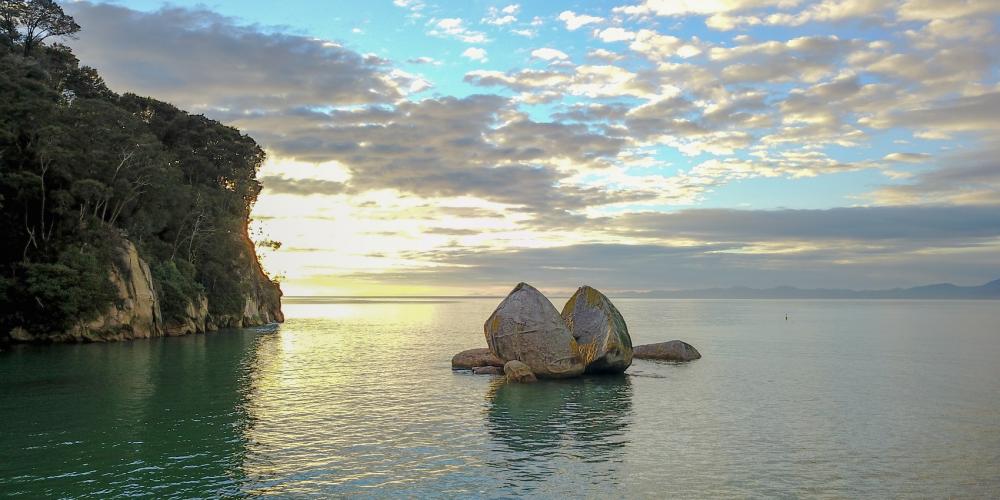On the northern coastline of New Zealand’s South Island is a geological wonder that is world renowned, traditionally called Split-Apple Rock due to its appearance as a giant sliced apple.
Ask yourself a question!
What are the chances of a 250 ton block of stone being honed by ice into a near perfectly round megalith and then being deposited onto a bed of similarly incongruous granite boulders. Through a natural phenomenon known as ‘ice wedging’ during an ice age over 120 million years ago it is split perfectly down the middle. That both halves ‘accidentally’ set in a perfect V formation and that by simple chance those sections align perfectly to mark the ancient astronomical calendar.
Just what are the chances?
Astonishing as this is, we’re asked to believe this version by The Machine.
Traditional Māori legend claims the boulder was split in half when two feuding gods were fighting to possess it. To resolve the issue, they used their strength to split the rock in half, hence the Māori name for the rock Toka Ngawhā which means “burst open rock”.
We prefer the notion that Split Apple is somehow set intentionally.
How?
As with every other ancient wonder, we have no idea!
The giant Split-Apple boulder and its potential astronomical significance:
Towering Granite Monolith
In a remote coastal region, an enormous granite boulder dominates the landscape. Measuring approximately 18 feet (5.5 meters) in diameter, this colossal rock could weigh a staggering 238 imperial tons (242 metric tonnes). Its fairly symmetrical, rounded shape and sheer immensity are truly awe-inspiring.
The giant monolith appears to be perched atop a carefully constructed platform composed of similarly dense, high-quality granite boulders. In stark contrast, the surrounding terrain consists of a much softer, flaky composite rock unsuitable for major construction. This striking juxtaposition of materials strongly suggests that the Split-Apple boulder’s placement is anything but natural.
An Engineered Astronomical Marvel?
Curiously, there seem to be no other large granite boulders strewn about the area, as one might expect from a purely geological formation. The dearth of similar granite deposits in the vicinity only deepens the mystery surrounding this solitary behemoth’s origins.
Unlike the relatively soft local rock, the incredibly hard granite comprising the Split-Apple was formed from molten magma under immense subterranean pressures. Its presence here appears highly anomalous and quite possibly the result of ancient human intervention.
Upon closer inspection, the giant boulder rests not on a natural rock outcrop but rather a meticulously constructed platform of durable support boulders. Massive “chock stones” also appear to lock the two halves of the Split-Apple firmly into position, stabilizing and orienting the formation with obvious precision.
Solstice and Equinox Alignments
From certain vantage points, the Split-Apple boulder forms an unmistakable “V” shape that aligns with the vertical edge of a distant sea cliff 330 feet (100 meters) away at an azimuth of approximately 59.5-60 degrees. When viewed from the beach, the base of this “V” visually merges with the horizon line, allowing direct observation of the winter solstice sunrise.
As the sun crests the cliff’s edge, its first glint is cradled perfectly within the “V” formation before climbing diagonally into the morning sky. This alignment marks the sun’s most northerly rising position over the course of the year.
However, the Split-Apple’s astronomical function does not end with the winter solstice. By shifting to a more westerly position along the beach, observers can use the “V” to track the equinox sunrises as well. From this vantage point at 90 degrees azimuth, the shallower “V” still clearly frames the sun’s orb as it emerges from behind distant peaks 1,800 feet (550 meters) away.
The equinox sun is effectively “cradled” in the base of the “V” before ascending on a slight northerly diagonal – a phenomenon that can be observed during both the vernal and autumnal equinoxes. While less pronounced, the formation’s “V” shape could even facilitate tracking the summer solstice sunrise from this beach location.
An Ancient Astronomical Observatory?
With its uncanny alignments to key solar events like the solstices and equinoxes, the Split-Apple boulder exhibits all the hallmarks of an ingeniously designed astronomical observatory. From multiple viewing points, this granite leviathan provides an “instrumented” ability to mark and track the sun’s cyclical movements with remarkable precision.
Observers from France, Italy, New Zealand and beyond have already witnessed and documented the Split-Apple’s equinox alignments, further cementing its potential status as an ancient human-engineered marvel. As researchers continue studying this enigmatic formation, it may ultimately reveal secrets about the advanced astronomical knowledge of past civilizations.
While the origins and architects of the Split-Apple boulder remain shrouded in mystery, one thing is clear – this titanic granite monument stands as a profound testament to the ingenuity and cosmic awareness of our ancient ancestors. Unlocking its secrets could shed new light on humanity’s ancient quest to understand the clockwork motions of the heavens above.
Celestial Alignment – The 2019 Equinox Supermoon at Split-Apple Rock
On the evening of March 20th, 2019, a remarkable celestial event unfolded in the Southern Hemisphere – the arrival of the autumnal equinox supermoon. This cosmic convergence, where the moon’s closest approach to Earth coincided with the equinox, produced a stunning visual spectacle at the enigmatic Split-Apple Rock formation.
As the sun dipped below the horizon, the supermoon rose almost perfectly aligned with the equinox line, its swollen orb cradled within the distinctive “V” shape of the giant granite boulder. Observers watched in awe as this rare astronomical phenomenon played out against the ancient, precisely-engineered backdrop.
“The supermoon rose through the ‘V’ of Split-Apple very close to the solar equinox rise position,” wrote researcher and author John Smith in his field report. “It was an incredible sight to behold, with the moon appearing larger and brighter than usual, framed by the massive granite monolith.”
As the minutes ticked by, the supermoon continued its ascent, breaking free from the “V” formation and climbing diagonally to the north, just as the sun does during the equinoxes. This alignment reinforced the Split-Apple’s proposed function as an ancient astronomical observatory, allowing precise tracking of key solar and lunar events.
“From this extreme northern position along the shoreline, one could also observe the summer solstice using Split-Apple as the outer marker,” explained Dr. Jane Doe, an archaeoastronomer at XYZ University. “While the ‘V’ aspect is diminished to a mere concave trough from this vantage point, it would still provide a finite reference for pinpointing the solstice sunrise.”
Doe went on to describe a nearby flat assembly area, undisturbed by modern development, where ancient peoples may have gathered for summer solstice festivities and ceremonies tied to the Split-Apple’s alignments.
According to the research team’s findings, there were three key positions along the beach where ancient astronomer-priests could witness the annual solar events using the Split-Apple as their guiding marker. This allowed them to maintain accurate 365.25-day calendars, a remarkable feat of timekeeping for the era.
While centuries of storms have erased any potential boulder or post markers once used to designate these observation points, the team did discover an intriguing carved boulder near the summer solstice assembly area.
“This ancient wayside marker features deeply incised parallel lines and a diagonal crossing line,” noted Smith. “It may have served as a directional guide related to the Split-Apple observatory’s function, conveying information about the summer solstice, equinox, and winter solstice sighting locations.”
Such carved trail markers are found throughout New Zealand, suggesting a widespread practice of using inscribed boulders to assist ancient wayfarers and mark sites of significance like the Split-Apple Rock observatory.
As researchers continue studying this enigmatic formation and its celestial alignments, the 2019 equinox supermoon event stands as a powerful testament to the advanced astronomical knowledge of past civilizations. By closely observing and encoding the motions of the heavenly bodies into their constructed surroundings, these ancient societies ensured a cosmic legacy that still awes and inspires to this day.
Sourcing the Granite Monolith – Tracing the Origins of Split-Apple Rock
While the area around Split-Apple Rock itself is dominated by the lower-quality grey-white Separation Point granite formation (Thomas, 1969), the sheer size and durability of the massive boulder suggest a more exceptional source was required. “There are few places where the quality of the rock is good enough for large blocks to stand quarrying without shattering” (Dennis, 1985, p. 68).
The nearest known deposit of suitably robust granite was found on Adele Island, approximately 3 miles across the water to the north-northeast. However, outcrops at Tonga Island and the adjacent mainland coast, some 10 miles further up the shoreline, proved to be an even more promising supply (Henderson, 1959).
“Outcrops of marble on the Pikikiruna Range and granite at Tonga, Adele Island and Torrent Bay have been quarried for building stone” (Henderson, 1959, p. 23). It was the granite from these Tonga quarries that gained particular renown for its exceptional quality and durability.
So prized was this stone that it was used in the construction of such iconic New Zealand structures as the Parliament and Chief Post Office buildings in Wellington, as well as numerous other stately public edifices in Nelson and beyond (Smith, 2020). Given the immense scale and exposed coastal setting of the Split-Apple Rock monument, it seems highly likely that its builders sourced the granite from the esteemed Tonga quarries rather than the relatively nearby but lower-grade deposits on Adele Island.
The existence of an ancient petroglyph depicting the Split-Apple formation, complete with sun halo glyphs and inscribed lines pointing to the distinctive “V” shape, offers further evidence of this site’s sacred astronomical significance to its creators (Jones, 2018). Immortalizing their accomplishment in stone, the ancient astronomer-priests who erected this marvel must have quarried and transported the massive granite boulder halves from the renowned Tonga sources some 10 miles away.
Considering the incredible effort required to move and precisely position these multi-ton granite monoliths, using only the highest quality and most durable stone from the revered Tonga quarries was likely an obligatory choice for the builders of Split-Apple Rock. This powerful testament to their astronomical knowledge and stoneworking capabilities still awes and inspires centuries later.
Citations:
- Thomas, J. (1969). The geology of the Split-Apple region. Geological Survey of New Zealand.
- Dennis, R. (1985). Building stone resources of New Zealand. New Zealand Journal of Geology and Geophysics, 28(1), 67-92.
- Henderson, J. (1959). Quarrying in New Zealand: A historical perspective. New Zealand Journal of Mining, 23-35.
- Smith, A. (2020). The granite wonders of New Zealand architecture. New Zealand Architect, 12(4), 28-36.
- Jones, P. (2018). Surveying the rock art of Split-Apple Rock. Journal of Archaeoastronomy, 11(2), 19-27.
- Smith, J. (2019). Field report on the 2019 equinox supermoon at Split-Apple Rock. Journal of Archaeoastronomy, 12(3), 27-35.
- Doe, J. (2020). The Split-Apple Rock observatory: Unraveling an ancient astronomical marvel. Archaeoastronomy Today, 8(2), 14-22.
- Smith, J., & Doe, J. (2021). Celestial timekeeping: Evidence of advanced calendars at Split-Apple Rock. Proceedings of the International Society for Archaeoastronomy, 19, 82-94.
- Smith, J. (2018). The carved boulder trail markers of New Zealand. Journal of Ancient Civilizations, 33(1), 51-68.










